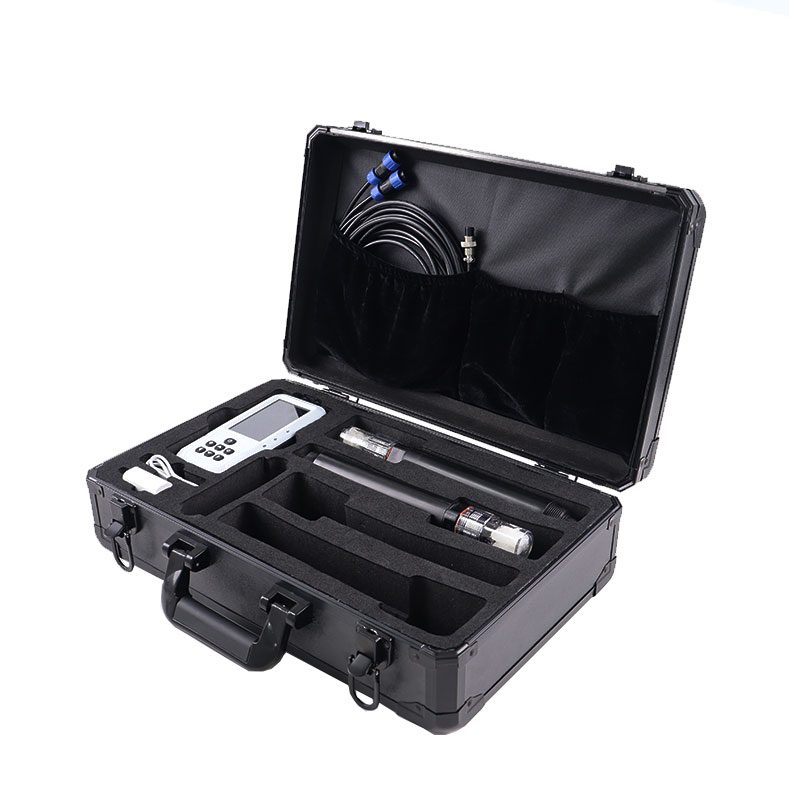Meteorological environment monitoring equipment supplier
Insist on doing high-precision customer favorite technology products

1. Aquaculture monitoring system product introduction
Aquaculture monitoring system is used to monitor aquaculture water quality such as water temperature, conductivity, PH and other parameters.The SS03B model Aquaculture monitoring system is an electrode method water quality analysis instrument that uses fully digital electrode detection to detect water quality, temperature, conductivity, and PH parameters.The instrument is equipped with the self-developed ftiot operating system, which is simple to operate, has stable performance, accurate measurement, and wide detection range.It has a built-in high-capacity rechargeable lithium battery, making it convenient for users to conduct water quality testing at any time in the field or laboratory.
2.Aquaculture monitoring system host parameters
| Charging input voltage | 4.5V-5.5V |
| Charging current | <2A |
| screen size | 3.5 inches |
| screen resolution | 480*800☆ |
| screen interface | MIPI DSI☆ |
| USB interface | 2 (Supports external expansion of mouse, keyboard, 4G, etc.)☆ |
| Type-C | 1 (Supports external expansion of mouse, keyboard, 4G, etc.)☆ |
| RS485 | 2 (Supports Modbus, json, asc input, etc.) |
| External sensor supply voltage | 12V |
| External sensor supply current | 1A |
| operating system | ftiot (based on Linux-5.4)☆ |
| CPU | 2*Cotex-A7, 650Mhz☆ |
| RAM | 512M DDR3☆ |
| Flash | 8G-64G |
| OpenGL | ES 2.0☆ |
| Wifi | support |
| 4G | Optional |
| button | support |
| capacitive touch screen | support |
| software architecture | B/S☆ |
| web access | Support☆ |
| MTP mode | Support☆ |
| Multiple terminal login | Support☆ |
| IPV6 | Support☆ |
| Sensor communication method | RS485, TCP, UDP, HTTP☆ |
| Data forwarding method | RS485, TCP, UDP, HTTP☆ |
| Remote SSH | Support☆ |
| remote debugging | Support☆ |
3.Aquaculture monitoring system sensor parameters and configuration
| serial number | name | Measuring range | principle | Measurement accuracy | Configuration | Remark |
| 1 | temperature | 0~50℃ | High-precision digital sensor | ±0.3℃ | ✔ | |
| 2 | pH | 0~14(ph) | Electrochemistry (Salt Bridge) | ±0.1PH | ✔ | |
| 3 | ORP | -1500mv~1500mv | Electrochemistry (Salt Bridge) | ±6mv | ||
| 4 | Conductivity | 0~5000uS/cm,0~10000uS/cm | contact electrode method | ±1.5% | ✔ | |
| 5 | TDS | 0~20μS/cm (TDS 0-10mg/L) | contact electrode method | ±1.5% | ||
| 6 | salinity | 0-2.5ppt or 0-80ppt | contact electrode method | ±0.05ppt or ±1ppt | ||
| 7 | Sludge concentration | 0~20.000g/L | scattered light method | ±5% (depending on sludge homogeneity) | ||
| 8 | Turbidity | 0~40NTU (low turbidity) | scattered light method | ±1% | Optional | |
| 0~1000NTU (medium turbidity) | scattered light method | ±1% | ||||
| 0~3000NTU (high turbidity) | scattered light method | ±1% | ||||
| 9 | Dissolved oxygen | 0~20mg/L | fluorescence lifetime method | ±2% | ||
| 10 | Ammonia nitrogen | 0-1000.00mg/L (default) 0-100.00mg/l/ (customizable) | Ion selective electrode method | 10% of reading, ±0.5℃ | ||
| 11 | suspended solids | 0~2000mg/L | scattered light method | ±5% (depending on sludge homogeneity) | ||
| 12 | Residual chlorine | 0~5.00mg/L | Ion selective electrode method | ±5% of reading | The accuracy is best when the flow rate is 0.42m/s-0.85m/s. | |
| 13 | Chloride ions | 0-3500.0mg/L | Ion selective electrode method | ±5% | ||
| 14 | Total hardness | 0~1000.0mg/L | Ion selective electrode method | ±10% of reading | ||
| 15 | cod | 0~500mg/L | UV254 absorption method | ±5% | COD and chlorophyll are equipped with automatic cleaners to prevent biological adhesion and avoid light window pollution to ensure long-term monitoring is still stable; the automatic cleaning time and cleaning frequency can be set, and the power consumption is 0.7W | |
| 16 | Chlorophyll | 0~400ug/L | Fluorescence method | R2>0.999 |